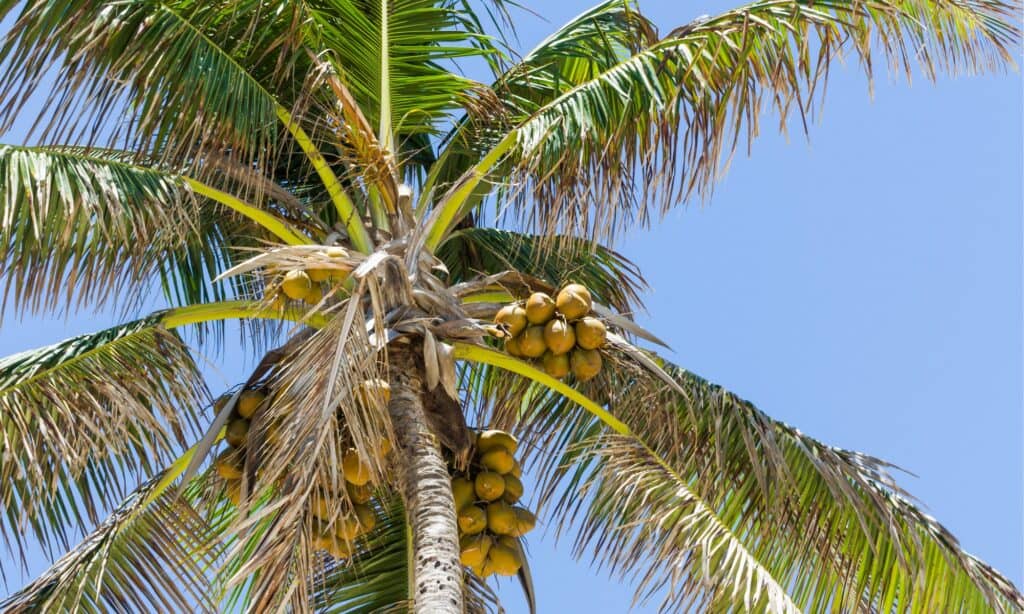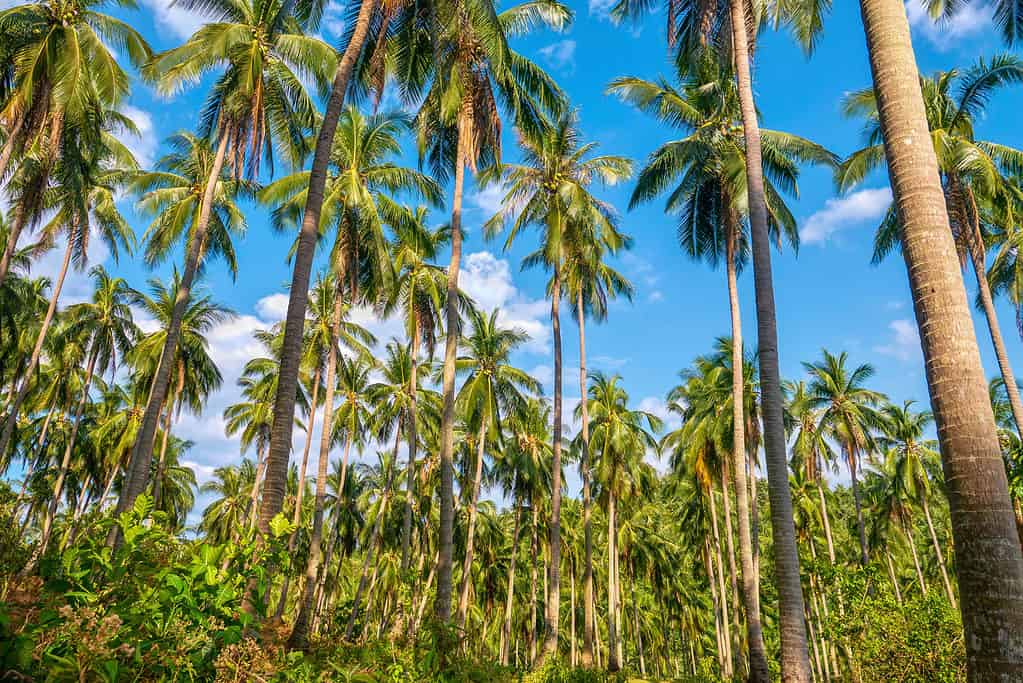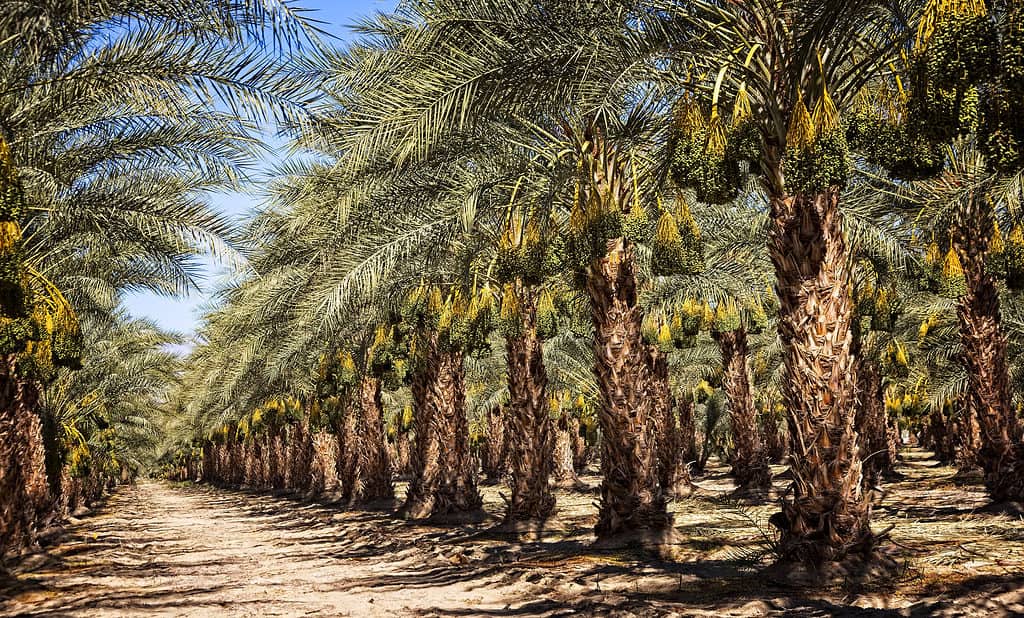Did you know that dates and coconuts both grow from palm trees? Well, they certainly do, so you have the wonderful world of palm trees to thank for these amazing fruits! Around the world, people enjoy these fruits and the gorgeous palm trees that produce them in a myriad of ways.
In this guide, we’ll compare date palm vs. coconut palm and discuss their plant classification, physical characteristics, native growing ranges and ideal growing conditions, and unique culinary uses.
So, without further ado, let’s dive in!
Date Palm vs. Coconut Palm: A Quick Look
| Date Palm | Coconut Palm | |
|---|---|---|
| Plant Classification | Phoenix dactylifera | Cocos nucifera |
| Physical Characteristics | Evergreen tree that produces dates and grows up to 50-100 feet tall. The leaves are pinnately compound with a gray-green tint. The stiff, waxy, pointed leaflets are narrow and feathery. Leaflets can grow 1-2 feet long and the entire arching leaves (fronds) can reach 10-16 feet long at maturity. Leaves are comprised of about 150 leaflets. Produces huge drooping clusters of pillowy, light yellow flowers where trunk meets the base of the leaves. Flowers give way to oblong fruits. | Evergreen tree that produces coconuts and grows up to 50-100 feet tall. Leaves are pinnately compound with a yellow-green tint. The stiff, waxy, pointed leaflets are narrow and feathery. The leaflet blades are 18-36 inches long. The arching leaves (fronds) can grow reach 15-20 feet long at maturity. Leaves are comprised of about 200-300 blade-like leaflets. Produces huge, elongated clusters (up to 4 feet long) of fragrant yellow flowers. Flowers give way to single-seed coconuts that can grow between 12-18 inches in length and 6-8 inches in diameter. |
| Native Range and Ideal Growing Conditions | Native range is North Africa and/or the Middle East. Grows in arid climates along river banks and near other water sources. Prefers to grow in full sun in well-draining, fertile soil. Requires low humidity and heat for productive fruiting. | Likely originated from Malay Archipelago. Now naturalized along tropical coastlines around the world. Thrives in USDA Hardiness Zones 10-12. Prefers to grow in moderately fertile, moist, and well-draining soil in full sun. |
| Culinary Uses and Nutritional Facts | Excellent snack or ingredient in a variety of sweet and savory dishes. Great source of dietary fiber. Good source of quick sugar and calories. | Wide range of culinary uses in drinks, savory dishes, and sweet dishes. Excellent source of fat, dietary fiber, copper, and manganese. |
Plant Classification
While date palm and coconut palm trees are both in the Arecaceae family of flowering plants, they belong to distinct genera and are separate species. Date palm is botanically classified as Phoenix dactylifera while coconut palm is classified as Cocos nucifera.
The Phoenix genus is comprised of 14 species of palm trees that cover a wide range of native growing regions from the Canary Islands, North and Central Africa, the Mediterranean, southern Asia, and Malaysia.
While the Phoenix genus contains 14 palm tree species, the Cocos genus is only comprised of the single species, Cocos nucifera.

or coconut palms produce coconuts that can grow between 12-18 inches in length and 6-8 inches in diameter.
©iStock.com/Thiago Santos
Date Palm vs. Coconut Palm: Physical Characteristics
Given the entirely distinct fruits, you can easily distinguish date palm vs. coconut palm when the trees are fruiting. However, when these palm trees are not producing fruit, telling them apart requires knowing more in-depth physical characteristics of each species.
You can best distinguish these palm species when not fruiting by looking at their trunks. While both are single-trunk trees, they have entirely distinct bark textures and colors. Date palm trunks are vividly red-brown and covered in short, spiny sheaths. In comparison, coconut palm trunks are grey-brown and do not produce spines. Rather, their trunks are much smoother and ringed.
Both trees grow 50-100 feet tall. They also both produce similar palm fronds with blade-like, stiff, and waxy leaflets. Date palm fronds are typically comprised of 150 leaflets while coconut palm fronds can contain 200-300 leaflets per frond. When flowering, they both produce huge, elongated clusters of tiny yellowish flowers that give way to their fruit.
Once fruiting, it’s easy to distinguish these two palm tree species. Date palms produce clusters of dates that droop in a ring around where the trunk meets the first level of palm fronds. These clusters can each weigh between 10-40 pounds, and a large tree can produce 8-12 bunches at a time. Date fruit is sticky in texture and typically 1-3 inches long when ripe. Ripe dates turn from green to red, golden brown, or black.
In comparison, mature coconut palm trees typically produce 15-20 coconuts per harvest. For cultivated coconut trees, growers usually harvest from the trees 15 times per season. Coconuts usually grow 14 inches in length and 6-8 inches in diameter.

Coconut palm tree trunks are smooth, ringed and do not produce spines.
©iStock.com/Cheryl Ramalho
Native Ranges and Ideal Growing Conditions
Regarding their native ranges, these species of palm trees originated far from each other. Botanists believe the date palm likely originated from North Africa and the Arabian Peninsula. In comparison, the coconut palm originated from the Malay Archipelago. While date palms have naturalized in Pakistan, Turkey, and Northwest India, the coconut palm has spread far beyond its point of origin and is naturalized along tropical coastal regions around the world.
Both trees have also spread through human cultivation to many areas of the world. For instance, you can find date palms growing in Florida even though this humid region is not its preferred climate. Indeed, date palms prefer to grow in hot, arid climates near water sources. They require full sun and dry heat for productive fruiting.
In contrast, coconut trees can grow in much more humid and moist regions. But they also require heat and full sun to thrive. Temperatures need to be over 64 degrees Fahrenheit to produce fruit. Both trees thrive in fertile, well-draining soil.

The date palm (
Phoenix dactylifera) grows in arid climates up to 100 feet tall, producing dates in clusters weighing between 10-40 pounds.
©iStock.com/Woodkern
Date Palm vs. Coconut Palm: Culinary Uses and Nutritional Facts
Regarding their culinary uses, both dates and coconuts have been important sources of food for thousands of years. Today, coconuts are the most naturally widely-spread fruit on Earth.

Dates provide an excellent source of dietary fiber and are a quick source of sugar and calories.
©iStock.com/Volosina
Culinary Uses
Particularly across North Africa, the Middle East, and the Mediterranean, people use dates in a variety of sweet and savory dishes. They also can be eaten right off the tree. They have a sticky, sweet taste and are often paired as snacks and appetizers with soft cheeses and crackers. Dates are popular ingredients in baked goods, candies, curries, and roasts.
In tropical regions across the world, people use coconuts in a variety of ways. You can crack the coconut open, drink the water inside, and eat the coconut “meat”. The coconut meat and water can be combined into coconut creams and milk for use in a variety of sweet and savory dishes. Coconut shavings are popular for use to top baked goods and candies. Indeed, regarding their culinary value, coconuts may be one of the most versatile fruits in the world.

Coconuts may be one of the most versatile fruits in the world as it is used as a drink, in sweet and savory dishes, baked goods and candies.
©Krzycho/Shutterstock.com
Nutritional Facts
Nutritionally, dates provide an excellent source of dietary fiber and are a quick source of sugar and calories. One date (about 24 grams) provides 66 calories, 16 grams of sugar, and 1.61 grams of fiber.
Regarding raw coconut’s nutritional value, coconut meat is an excellent source of fat, dietary fiber, copper, and manganese. Coconut water is also a great source of sodium, magnesium, potassium, and manganese. One cup of raw shredded coconut provides 283 calories, 120% daily recommended value of saturated fats, 26% of dietary fiber, 39% of copper, and 52% of manganese. One cup of coconut water provides an excellent source of electrolytes with 11% of the daily recommended sodium intake, 13% of potassium, 14% of magnesium, and 15% of manganese.
Up Next
- Can Dogs Drink Coconut Water? Is It Safe or Dangerous?
- The 4 Best Coconut Oils for Dogs: Reviewed for 2022
- Can Dogs Eat Dates or Not? What Science Says
The photo featured at the top of this post is © iStock.com/Viktoriya Fivko
Sources
- Virtual Library of Phoenix Landscape Plants, Available here: https://www.public.asu.edu/~camartin/plants/Plant%20html%20files/phoenixdactylifera.html
- Missouri Botanical Garden, Available here: https://www.missouribotanicalgarden.org/PlantFinder/PlantFinderDetails.aspx?taxonid=276638
- National Library of Medicine, Available here: https://www.ncbi.nlm.nih.gov/pmc/articles/PMC4671521/
- Nutrition Value, Available here: https://www.nutritionvalue.org/Dates%2C_medjool_nutritional_value.html
- Nutrition Value, Available here: https://www.nutritionvalue.org/Nuts%2C_raw%2C_coconut_meat_nutritional_value.html
- Nutrition Value, Available here: https://www.nutritionvalue.org/Nuts%2C_coconut_water_%28liquid_from_coconuts%29_nutritional_value.html
Thank you for reading! Have some feedback for us? Contact the AZ Animals editorial team.







